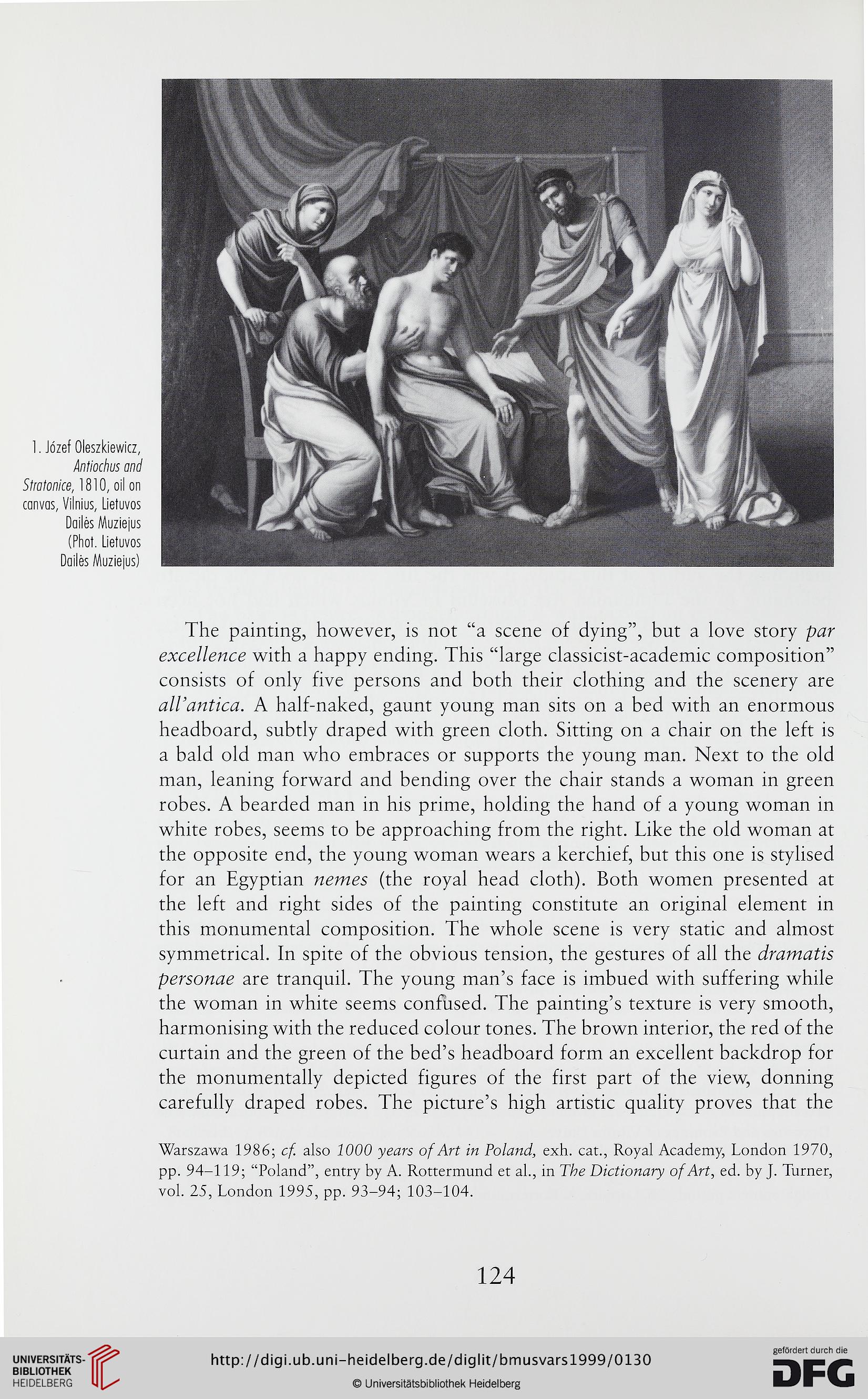1. Józef Oleszkiewicz,
Antiochus and
Slralonice, 1810, oil on
canvas, Vilnius, Lietuvos
Dailes Muziejus
(Phot. Lietuvos
Doiłeś Muziejus)
The painting, however, is not “a scene of dying”, but a love story par
excellence with a happy ending. This “large classicist-academic composition”
consists of only five persons and both their clothing and the scenery are
all’antica. A half-naked, gaunt young man sits on a bed with an enormous
headboard, subtly draped with green cloth. Sitting on a chair on the left is
a bald old man who embraces or supports the young man. Next to the old
man, leaning forward and bending over the chair stands a woman in green
robes. A bearded man in his prime, holding the hand of a young woman in
white robes, seems to be approaching from the right. Like the old woman at
the opposite end, the young woman wears a kerchief, but this one is stylised
for an Egyptian nemes (the royal head cloth). Both women presented at
the left and right sides of the painting constitute an original element in
this monumental composition. The whole scene is very static and almost
symmetrical. In spite of the obvious tension, the gestures of all the dramatis
personae are tranąuil. The young man’s face is imbued with suffering while
the woman in white seems confused. The painting’s texture is very smooth,
harmonising with the reduced colour tones. The brown interior, the red of the
curtain and the green of the bed’s headboard form an excellent backdrop for
the monumentally depicted figures of the first part of the view, donning
carefully draped robes. The picture’s high artistic ąuality proves that the
Warszawa 1986; cf. also 1000 years of Art in Poland, exh. cat., Royal Academy, London 1970,
pp. 94-119; “Poland”, entry by A. Rottermund et al., in The Dictionary of Art, ed. by J. Turner,
vol. 25, London 1995, pp. 93-94; 103-104.
124
Antiochus and
Slralonice, 1810, oil on
canvas, Vilnius, Lietuvos
Dailes Muziejus
(Phot. Lietuvos
Doiłeś Muziejus)
The painting, however, is not “a scene of dying”, but a love story par
excellence with a happy ending. This “large classicist-academic composition”
consists of only five persons and both their clothing and the scenery are
all’antica. A half-naked, gaunt young man sits on a bed with an enormous
headboard, subtly draped with green cloth. Sitting on a chair on the left is
a bald old man who embraces or supports the young man. Next to the old
man, leaning forward and bending over the chair stands a woman in green
robes. A bearded man in his prime, holding the hand of a young woman in
white robes, seems to be approaching from the right. Like the old woman at
the opposite end, the young woman wears a kerchief, but this one is stylised
for an Egyptian nemes (the royal head cloth). Both women presented at
the left and right sides of the painting constitute an original element in
this monumental composition. The whole scene is very static and almost
symmetrical. In spite of the obvious tension, the gestures of all the dramatis
personae are tranąuil. The young man’s face is imbued with suffering while
the woman in white seems confused. The painting’s texture is very smooth,
harmonising with the reduced colour tones. The brown interior, the red of the
curtain and the green of the bed’s headboard form an excellent backdrop for
the monumentally depicted figures of the first part of the view, donning
carefully draped robes. The picture’s high artistic ąuality proves that the
Warszawa 1986; cf. also 1000 years of Art in Poland, exh. cat., Royal Academy, London 1970,
pp. 94-119; “Poland”, entry by A. Rottermund et al., in The Dictionary of Art, ed. by J. Turner,
vol. 25, London 1995, pp. 93-94; 103-104.
124





